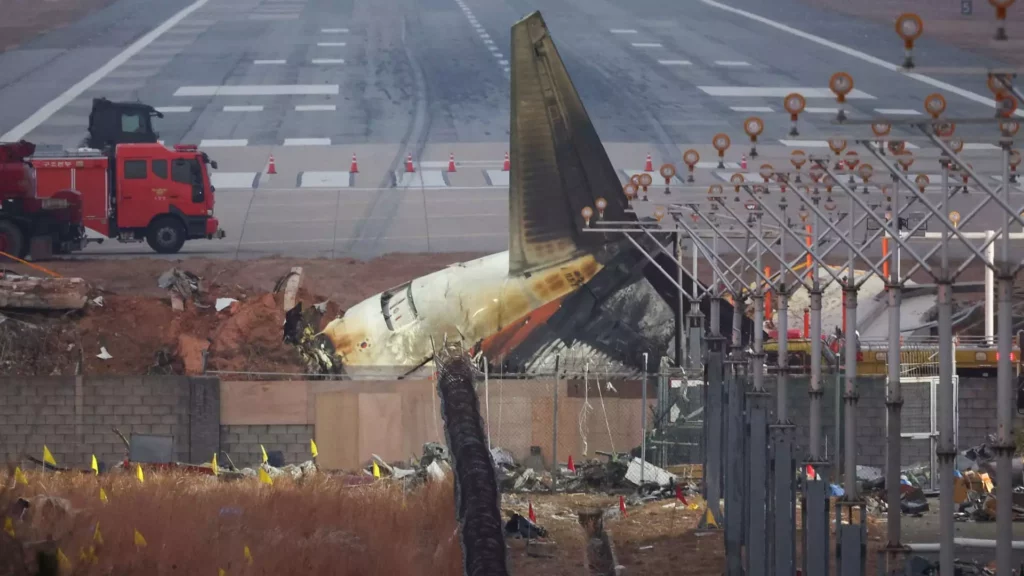The catastrophic crash of a Jeju Air flight over the weekend, which led to the tragic loss of 179 lives out of the 181 aboard, has cast a shadow over South Korea’s aviation sector. The unthinkable event occurred shortly after the aircraft, a Boeing 737-800, attempted a landing at Muan International Airport. Reports indicate that the plane skidded off the runway and collided with a concrete structure before bursting into flames. The distressing incident has raised alarms and forced South Korean authorities to launch an immediate investigation into the safety and operational integrity of the entire fleet of 737-800 aircraft being operated by local airlines.
In a rapid response to the disaster, South Korea’s acting President Choi Sang-mok instructed the Transport Ministry to conduct emergency safety inspections across the nation’s airlines. This directive is not merely a procedural formality; it symbolizes a commitment to ensuring the safety of air travel amidst rising concerns regarding the operational standards of domestic flights. The Ministry of Land, Infrastructure, and Transport (MOLIT) announced that a “comprehensive special inspection” of the Boeing 737-800 aircraft was set in motion, as officials aim to unravel the events that led to the horrific crash.
The complexity of the situation is compounded by the uncertainty surrounding the exact cause of the incident. Preliminary reports indicate that the pilot had reported a “bird strike” shortly after takeoff, and moments later declared a “Mayday.” This compels investigators to consider the possible technical failures or external environmental factors that may have contributed to the tragedy.
The U.S. National Transportation Safety Board (NTSB), along with representatives from the Federal Aviation Administration and Boeing, is collaborating with South Korea’s Aviation and Railway Accident Investigation Board to delve into the incident. The retrieval and subsequent analysis of the plane’s black boxes are poised to yield vital information which may shed light on what transpired during the flight. The involvement of CFM International—an engine manufacturer that operates under a partnership of GE Aerospace and Safran Aircraft Engines—highlights the multi-faceted approach being taken to ensure a thorough investigation.
Given the timing and severity of this crash, there is an ongoing examination of various aspects, including the infrastructure of Muan International Airport itself. MOLIT’s review of the concrete wall that the aircraft struck suggests that investigators are seeking to ascertain whether environmental conditions contributed to the mishap.
Despite the unfortunate crash, aviation experts remain optimistic regarding the Boeing 737-800 model’s safety record. The aircraft has been in operation for nearly three decades and has garnered a strong reputation, boasting a high level of reliability relative to its contemporaries. With approximately 4,400 units currently in service, the Boeing 737-800 accounts for about 17% of the global jet fleet, a statistic which underscores its widespread acceptance among airlines worldwide.
The model is particularly prominent in South Korea, where Jeju Air operates the largest fleet of 39 such aircraft. Other airlines such as T’way Air, Jin Air, Eastar Jet, and Korean Air also utilize this model, relying on its history of safety to maintain public confidence. However, the recent crash serves as a stark reminder of the implications of incidents for even a well-regarded aircraft.
In the wake of the tragedy, Jeju Air has faced a significant backlash, with shares plummeting to an all-time low. The stock market reaction highlights the heightened scrutiny and loss of confidence in the airline’s operational methods. Jeju Air management has vowed to cooperate fully with investigations while offering support to victims’ families. They have publicly asserted that mechanical faults or inadequate safety measures did not contribute to the crash, but that statement remains to be substantiated.
Furthermore, the incident raises questions about the broader implications for South Korea’s aviation industry, which has seen remarkable growth and increasing competition in recent years. The evolving landscape may compel tighter regulations, particularly concerning issues such as bird strikes—a factor that investigators have flagged as a potential cause.
As investigations continue and safety protocols are reassessed, the aviation community must reflect upon the balance between operational demands and safety standards. The tragic crash of the Jeju Air flight serves as a harrowing reminder of the risks inherent in air travel and the unyielding need for vigilance in aviation safety practices. There is an urgent call for comprehensive safety measures, better emergency protocols, and potentially significant regulatory adjustments that could shape the future of South Korean aviation and beyond.

